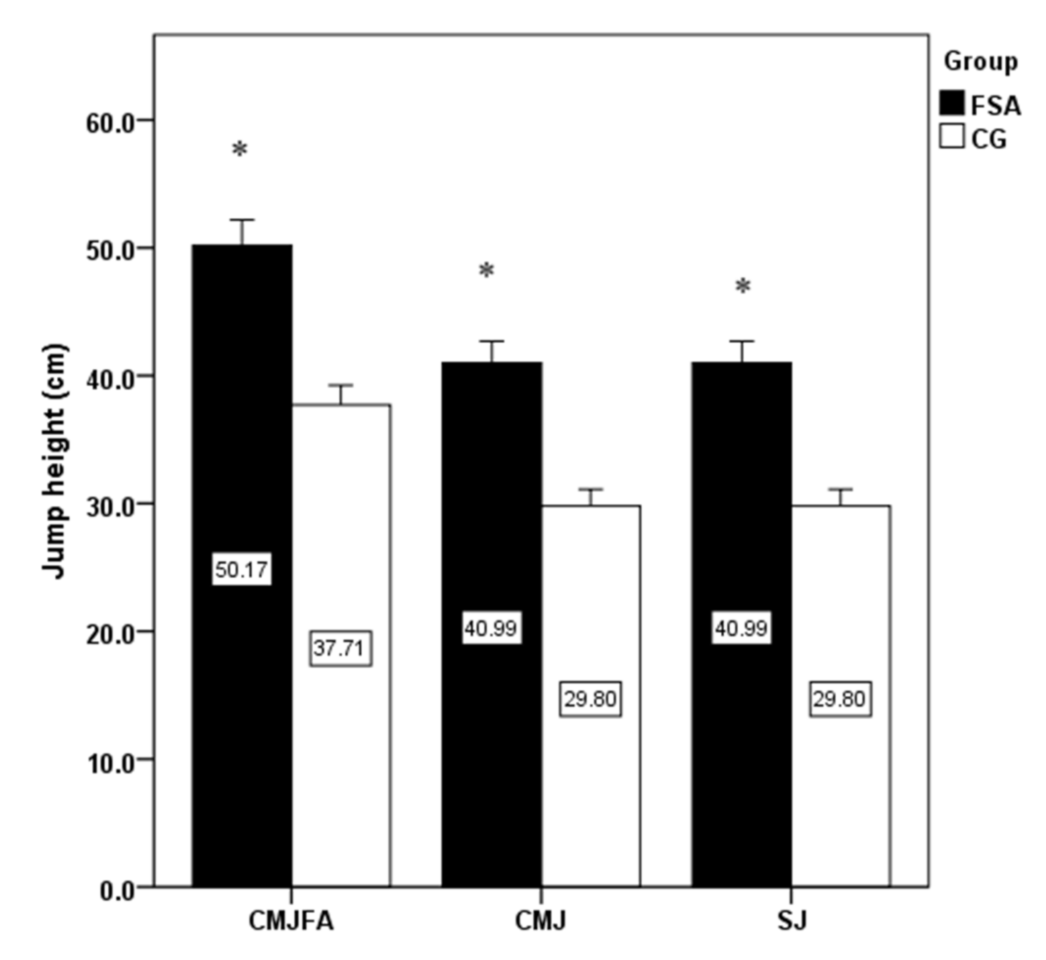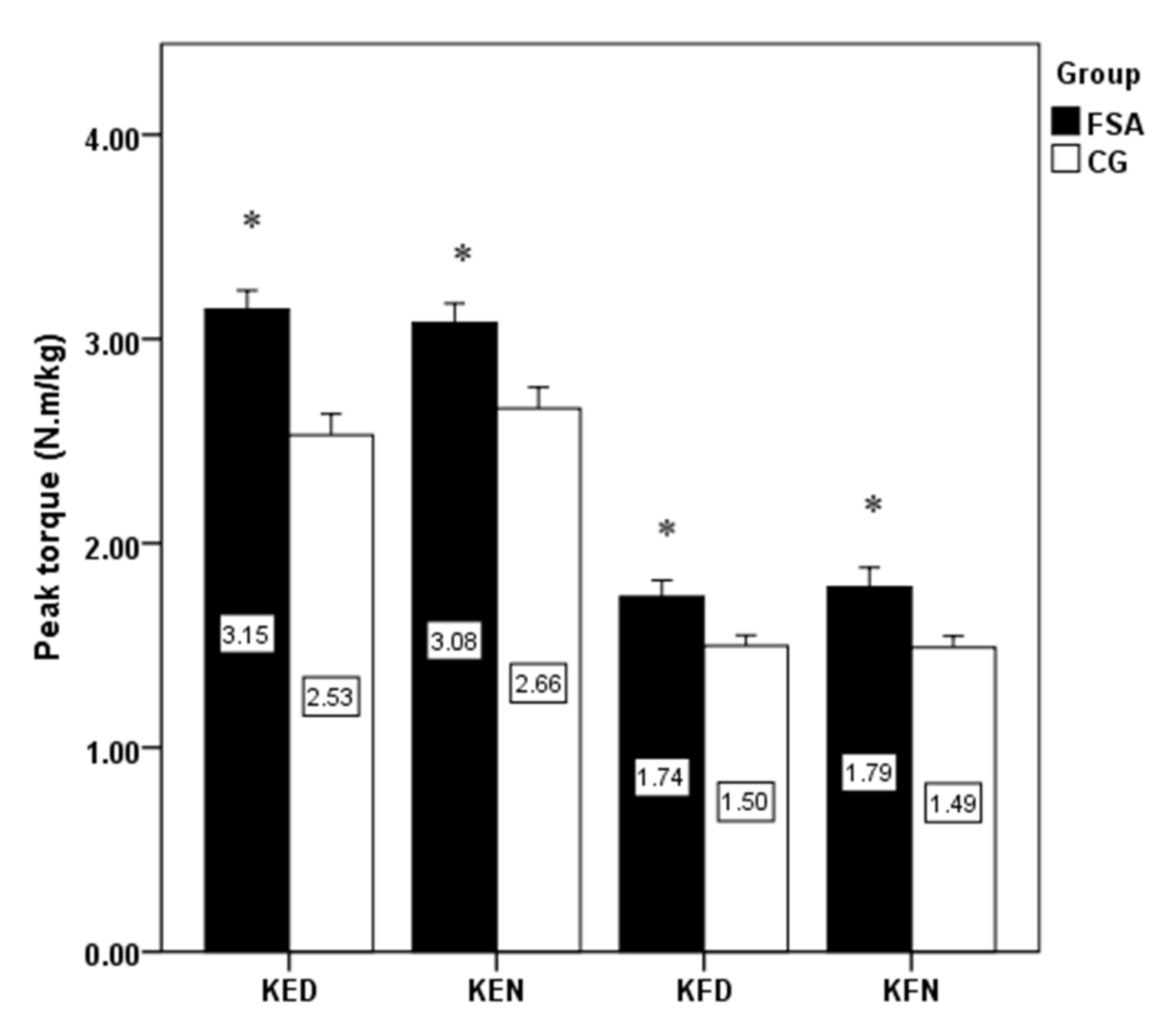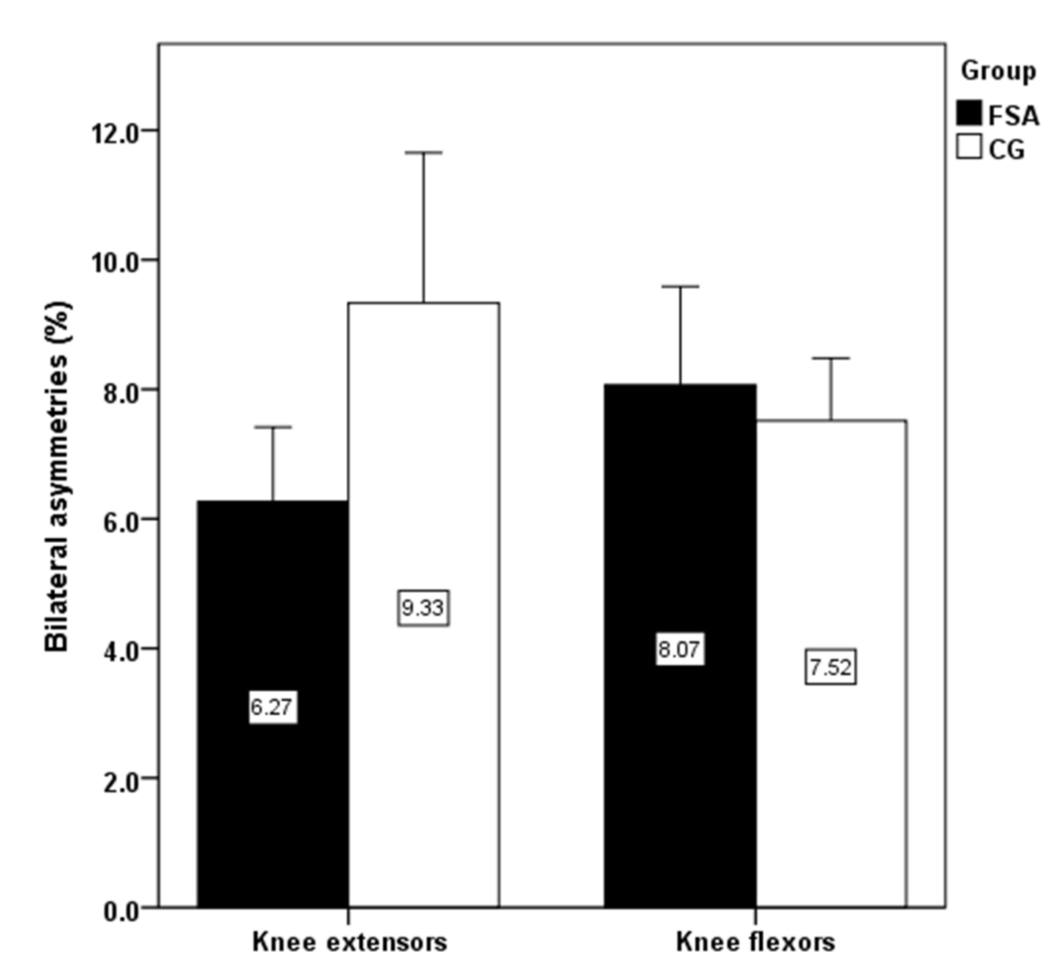Isokinetic Strength, Vertical Jump Performance, and Strength Differences in First Line Professional Firefighters Competing in Fire Sport
Abstract
:1. Introduction
2. Materials and Methods
2.1. Study Design
2.2. Participants
2.3. Anthropometric Procedure
2.4. Muscle Strength
2.5. Statistical Analyses
3. Results
4. Discussion
5. Conclusions
Author Contributions
Funding
Institutional Review Board Statement
Informed Consent Statement
Conflicts of Interest
References
- Soteriades, E.S.; Smith, D.L.; Tsismenakis, A.J.; Baur, D.M.; Kales, S.N. Cardiovascular disease in US firefighters: A systematic review. Cardiol. Rev. 2011, 19, 202–215. [Google Scholar] [CrossRef] [PubMed]
- Scofield, D.E.; Kardouni, J.R. The Tactical Athlete: A Product of 21st Century Strength and Conditioning. Strength Cond. J. 2015, 37, 2–7. [Google Scholar] [CrossRef]
- Bycura, D.K.; Dmitrieva, N.O.; Santos, A.C.; Waugh, K.L.; Ritchey, K.M. Efficacy of a Goal Setting and Implementation Planning Intervention on Firefighters’ Cardiorespiratory Fitness. J. Strength Cond. Res. 2019, 33, 3151–3161. [Google Scholar] [CrossRef]
- Poplin, G.S.; Roe, D.J.; Peate, W.; Harris, R.B.; Burgess, J.L. The association of aerobic fitness with injuries in the fire service. Am. J. Epidemiol. 2014, 179, 149–155. [Google Scholar] [CrossRef] [PubMed]
- Haynes, H.J.; Molis, J.L. United States Firefighter Injuries-2016. Available online: https://www.nfpa.org/News-and-Research/Publications-and-media/NFPA-Journal/2017/November-December-2017 (accessed on 17 August 2017).
- Beach, T.A.; Frost, D.M.; McGill, S.M.; Callaghan, J.P. Physical fitness improvements and occupational low-back loading-an exercise intervention study with firefighters. Ergonomics 2014, 57, 744–763. [Google Scholar] [CrossRef]
- Pawlak, R.; Clasey, J.L.; Palmer, T.; Symons, T.B.; Abel, M.G. The effect of a novel tactical training program on physical fitness and occupational performance in firefighters. J. Strength Cond. Res. 2015, 29, 578–588. [Google Scholar] [CrossRef] [PubMed]
- Kalata, M.; Maly, T.; Hank, M.; Michalek, J.; Bujnovsky, D.; Kunzmann, E.; Zahalka, F. Unilateral and Bilateral Strength Asymmetry among Young Elite Athletes of Various Sports. Medicina 2020, 56, 683. [Google Scholar] [CrossRef] [PubMed]
- Twomey, L.; Taylor, J. The lumbar spine: Structure, function, age changes and physiotherapy. Aust. J. Physiother. 1994, 40, 19–30. [Google Scholar] [CrossRef] [Green Version]
- Michaelides, M.A.; Parpa, K.M.; Henry, L.J.; Thompson, G.B.; Brown, B.S. Assessment of physical fitness aspects and their relationship to firefighters’ job abilities. J. Strength Cond. Res. 2011, 25, 956–965. [Google Scholar] [CrossRef]
- Maestroni, L.; Read, P.; Bishop, C.; Papadopoulos, K.; Suchomel, T.J.; Comfort, P.; Turner, A. The benefits of strength training on musculoskeletal system health: Practical applications for interdisciplinary care. Sports Med. 2020, 50, 1431–1450. [Google Scholar] [CrossRef]
- Storer, T.W.; Dolezal, B.A.; Abrazado, M.L.; Smith, D.L.; Batalin, M.A.; Tseng, C.H.; Cooper, C.B.; Group, P.S. Firefighter health and fitness assessment: A call to action. J. Strength Cond. Res. 2014, 28, 661–671. [Google Scholar] [CrossRef]
- Vaara, J.P.; Kokko, J.; Isoranta, M.; Kyrolainen, H. Effects of Added Resistance Training on Physical Fitness, Body Composition, and Serum Hormone Concentrations During Eight Weeks of Special Military Training Period. J. Strength Cond. Res. 2015, 29 (Suppl. 11), S168–S172. [Google Scholar] [CrossRef]
- Maly, T.; Sugimoto, D.; Izovska, J.; Zahalka, F.; Mala, L. Effect of Muscular Strength, Asymmetries and Fatigue on Kicking Performance in Soccer Players. Int. J. Sports Med. 2018, 39, 297–303. [Google Scholar] [CrossRef] [PubMed]
- Heinert, B.L.; Collins, T.; Tehan, C.; Ragan, R.; Kernozek, T.W. Effect of Hamstring-to-quadriceps Ratio on Knee Forces in Females During Landing. Int. J. Sports Med. 2021, 42, 264–269. [Google Scholar] [CrossRef] [PubMed]
- Baratta, R.; Solomonow, M.; Zhou, B.H.; Letson, D.; Chuinard, R.; D’Ambrosia, R. Muscular coactivation. The role of the antagonist musculature in maintaining knee stability. Am. J. Sports Med. 1988, 16, 113–122. [Google Scholar] [CrossRef] [PubMed]
- Zvijac, J.E.; Toriscelli, T.A.; Merrick, S.; Kiebzak, G.M. Isokinetic concentric quadriceps and hamstring strength variables from the NFL Scouting Combine are not predictive of hamstring injury in first-year professional football players. Am. J. Sports Med. 2013, 41, 1511–1518. [Google Scholar] [CrossRef] [PubMed]
- Orchard, J.; Marsden, J.; Lord, S.; Garlick, D. Preseason hamstring muscle weakness associated with hamstring muscle injury in Australian footballers. Am. J. Sports Med. 1997, 25, 81–85. [Google Scholar] [CrossRef]
- Kong, P.W.; Burns, S.F. Bilateral difference in hamstrings to quadriceps ratio in healthy males and females. Phys. Ther. Sport 2010, 11, 12–17. [Google Scholar] [CrossRef]
- Maly, T.; Mala, L.; Bujnovsky, D.; Hank, M.; Zahalka, F. Morphological and Isokinetic Strength Differences: Bilateral and Ipsilateral Variation by Different Sport Activity. Open Med. 2019, 14, 207–216. [Google Scholar] [CrossRef]
- McGill, S.M. Low Back Disorders, 3rd ed.; Human Kinetics, Inc.: Champaign, IL, USA, 2016; pp. 187–191. [Google Scholar]
- Krzykała, M.; Leszczyński, P.; Grześkowiak, M.; Podgórski, T.; Woźniewicz-Dobrzyńska, M.; Konarska, A.; Strzelczyk, R.; Lewandowski, J.; Konarski, J. Does field hockey increase morphofunctional asymmetry? A pilot study. Homo 2018, 69, 43–49. [Google Scholar] [CrossRef]
- Harriss, D.J.; Macsween, A.; Atkinson, G. Standards for Ethics in Sport and Exercise Science Research: 2018 Update. Int. J. Sports Med. 2017, 38, 1126–1131. [Google Scholar] [CrossRef] [PubMed] [Green Version]
- Ford, K.R.; Myer, G.D.; Hewett, T.E. Valgus knee motion during landing in high school female and male basketball players. Med. Sci. Sports Exerc. 2003, 35, 1745–1750. [Google Scholar] [CrossRef] [PubMed] [Green Version]
- Glatthorn, J.F.; Gouge, S.; Nussbaumer, S.; Stauffacher, S.; Impellizzeri, F.M.; Maffiuletti, N.A. Validity and reliability of Optojump photoelectric cells for estimating vertical jump height. J. Strength Cond. Res. 2011, 25, 556–560. [Google Scholar] [CrossRef]
- Linthorne, N.P. Analysis of standing vertical jumps using a force platform. Am. J. Phys. 2001, 69, 1198–1204. [Google Scholar] [CrossRef] [Green Version]
- Sugimoto, D.; McCartney, R.E.; Parisien, R.L.; Dashe, J.; Borg, D.R.; Meehan, W.P., 3rd. Range of motion and ankle injury history association with sex in pediatric and adolescent athletes. Phys. Sportsmed 2018, 46, 24–29. [Google Scholar] [CrossRef]
- Cohen, J. A power primer. Psychol. Bull. 1992, 112, 155–159. [Google Scholar] [CrossRef]
- Lindberg, A.S.; Oksa, J.; Malm, C. Laboratory or field tests for evaluating firefighters’ work capacity? PLoS ONE 2014, 9, e91215. [Google Scholar] [CrossRef] [PubMed]
- Cornell, D.J.; Gnacinski, S.L.; Meyer, B.B.; Ebersole, K.T. Changes in Health and Fitness in Firefighter Recruits: An Observational Cohort Study. Med. Sci. Sports Exerc. 2017, 49, 2223–2233. [Google Scholar] [CrossRef]
- Perroni, F.; Cignitti, L.; Cortis, C.; Capranica, L. Physical fitness profile of professional Italian firefighters: Differences among age groups. Appl. Ergon. 2014, 45, 456–461. [Google Scholar] [CrossRef]
- Dawes, J.J.; Lindsay, K.; Bero, J.; Elder, C.; Kornhauser, C.; Holmes, R. Physical Fitness Characteristics of High vs. Low Performers on an Occupationally Specific Physical Agility Test for Patrol Officers. J. Strength Cond. Res. 2017, 31, 2808–2815. [Google Scholar] [CrossRef] [PubMed]
- Frio Marins, E.; Daves, J.J.; Cabistany, L.; Bartel, C.; Boscolo Del Vecchio, F. Aerobic fitness, upper-body strength and agility predict performance on an occupational physical ability test among police officers while wearing personal protective equipment. J. Sports Med. Phys. Fit. 2019, 59, 1835–1844. [Google Scholar] [CrossRef]
- Stone, B.L.; Alvar, B.A.; Orr, R.M.; Lockie, R.G.; Johnson, Q.R.; Goatcher, J.; Dawes, J.J. Impact of an 11-Week Strength and Conditioning Program on Firefighter Trainee Fitness. Sustainability 2020, 12, 6541. [Google Scholar] [CrossRef]
- Ferreira, J.C.; Araujo, S.R.S.; Pimenta, E.M.; Menzel, H.J.K.; Medeiros, F.B.; de Andrade, A.G.P.; Ocarino, J.D.; Chagas, M.H. Impact of Competitive Level and Age on the Strength and Asymmetry of Young Soccer Players. Rev. Bras. Med. Esporte 2018, 24, 357–360. [Google Scholar] [CrossRef]
- Centeno-Prada, R.A.; Lopez, C.; Naranjo-Orellana, J. Jump percentile: A proposal for evaluation of high level sportsmen. J. Sports Med. Phys. Fit. 2015, 55, 464–470. [Google Scholar]
- Noh, K.; Lee, K.; Jamrasi, P.; Zhang, Y.; Park, S.; Seo, D.; Park, J.J.; Lee, H.; Kang, H.; Lee, C.G.; et al. Physical fitness levels of South Korean national male and female firefighters. J. Exerc. Sci. Fit. 2020, 18, 109–114. [Google Scholar] [CrossRef]
- Gerstner, G.R.; Giuliani, H.K.; Mota, J.A.; Ryan, E.D. Influence of Muscle Quality on the Differences in Strength From Slow to Fast Velocities in Career Firefighters. J. Strength Cond. Res. 2018, 32, 2982–2986. [Google Scholar] [CrossRef]
- Menzel, H.J.; Chagas, M.H.; Szmuchrowski, L.A.; Araujo, S.R.; de Andrade, A.G.; de Jesus-Moraleida, F.R. Analysis of lower limb asymmetries by isokinetic and vertical jump tests in soccer players. J. Strength Cond. Res. 2013, 27, 1370–1377. [Google Scholar] [CrossRef] [PubMed]
- Maly, T.; Mala, L.; Zahalka, F.; Hank, M.; Simkova, M. Muscular strength of knee extensors and flexors and bilateral and ipsilateral ratio in elite male kickboxers. Arch. Budo 2017, 13, 107–116. [Google Scholar]
- Siqueira, C.M.; Pelegrini, F.R.M.M.; Fontana, M.F.; Greve, J.M.D. Isokinetic dynamometry of knee flexors and extensors: Comparative study among non-athletes, jumper athletes and runner athletes. Rev. Hosp. Clin. 2002, 57, 19–24. [Google Scholar] [CrossRef] [Green Version]
- Liporaci, R.F.; Saad, M.; Grossi, D.B.; Riberto, M. Clinical Features and isokinetic Parameters in Assessing Injury Risk in elite Football Players. Int. J. Sports Med. 2019, 40, 903–908. [Google Scholar] [CrossRef]
- Delisle, A.T.; Piazza-Gardner, A.K.; Cowen, T.L.; Huq, M.B.S.; Delisle, A.D.; Stopka, C.B.; Tillman, M.D. Validation of a cardiorespiratory fitness assessment for firefighters. J. Strength Cond. Res. 2014, 28, 2717–2723. [Google Scholar] [CrossRef] [PubMed]
- Poston, W.S.; Haddock, C.K.; Jahnke, S.A.; Jitnarin, N.; Tuley, B.C.; Kales, S.N. The prevalence of overweight, obesity, and substandard fitness in a population-based firefighter cohort. J. Occup. Environ. Med. 2011, 53, 266. [Google Scholar] [CrossRef] [PubMed] [Green Version]
- Dobson, M.; Choi, B.; Schnall, P.L.; Wigger, E.; Garcia-Rivas, J.; Israel, L.; Baker, D.B. Exploring occupational and health behavioral causes of firefighter obesity: A qualitative study. Am. J. Ind. Med. 2013, 56, 776–790. [Google Scholar] [CrossRef] [PubMed]




| Parameters | Descriptive Statistic | ANOVA | Bonferroni’s Post-Hoc Test | |||||
|---|---|---|---|---|---|---|---|---|
| Mean | SD | 95% CI Interval | F | p | ||||
| Lower | Upper | |||||||
| JH (cm) | CMJFA | 50.17 | 7.84 | 45.83 | 54.51 | 7.23 | 0.00 | CMJFA vs. CMJ, SQJ |
| CMJ | 43.64 | 5.87 | 40.39 | 46.89 | ||||
| SQJ | 40.99 | 6.57 | 37.36 | 44.63 | ||||
| VGRF (N.kg−1) | CMJFA | 25.51 | 1.67 | 24.53 | 26.39 | 16.03 | 0.00 | CMJFA vs. SQJ, CMJ vs. SQJ |
| CMJ | 26.10 | 3.43 | 24.23 | 27.69 | ||||
| SQJ | 21.09 | 2.35 | 19.72 | 22.56 | ||||
| ΔVGRF (%) | CMJFA | 5.50 | 4.50 | 3.01 | 7.99 | 3.45 | 0.04 | CMJ vs. SQJ |
| CMJ | 8.90 | 6.74 | 5.16 | 12.63 | ||||
| SQJ | 4.15 | 3.54 | 2.19 | 6.11 | ||||
| ΔVGRFt−o (%) | CMJFA | 4.46 | 3.40 | 2.58 | 6.34 | 0.20 | 0.82 | |
| CMJ | 4.50 | 3.44 | 2.59 | 6.40 | ||||
| SQJ | 3.79 | 3.50 | 1.85 | 5.72 | ||||
| Jump Test | Dominant Limb | Non-Dominant Limb | t | Sig. | d | Effect Size | ||
|---|---|---|---|---|---|---|---|---|
| Mean | SD | Mean | SD | |||||
| CMJFA | 12.85 | 0.89 | 12.66 | 0.98 | 1.01 | n.s. | 0.21 | small |
| CMJ | 12.85 | 1.67 | 13.24 | 2.16 | −0.91 | n.s. | 0.20 | small |
| SQJ | 10.60 | 1.47 | 10.60 | 1.08 | 0.30 | n.s. | 0.00 | small |
| Variable | Dominant Limb | Non-Dominant Limb | t | Sig. | d | Effect Size | ||
|---|---|---|---|---|---|---|---|---|
| Mean | SD | Mean | SD | |||||
| KE (Nm/kg) | 3.15 | 0.36 | 3.08 | 0.37 | 1.07 | n.s. | 0.19 | small |
| KF(Nm/kg) | 1.74 | 0.31 | 1.79 | 0.37 | −0.86 | n.s. | 0.15 | small |
| Unilateral differences | ||||||||
| Dominant limb | Non-dominant limb | |||||||
| UR (%) | 55.31 | 7.51 | 58.12 | 10.26 | −1.30 | n.s. | 0.53 | medium |
| Bilateral differences | ||||||||
| Knee extensors | Knee flexors | |||||||
| BR (%) | 6.27 | 4.45 | 8.07 | 5.89 | −1.18 | n.s. | 0.35 | small |
Publisher’s Note: MDPI stays neutral with regard to jurisdictional claims in published maps and institutional affiliations. |
© 2021 by the authors. Licensee MDPI, Basel, Switzerland. This article is an open access article distributed under the terms and conditions of the Creative Commons Attribution (CC BY) license (http://creativecommons.org/licenses/by/4.0/).
Share and Cite
Miratsky, P.; Gryc, T.; Cabell, L.; Zahalka, F.; Brozka, M.; Varjan, M.; Maly, T. Isokinetic Strength, Vertical Jump Performance, and Strength Differences in First Line Professional Firefighters Competing in Fire Sport. Int. J. Environ. Res. Public Health 2021, 18, 3448. https://doi.org/10.3390/ijerph18073448
Miratsky P, Gryc T, Cabell L, Zahalka F, Brozka M, Varjan M, Maly T. Isokinetic Strength, Vertical Jump Performance, and Strength Differences in First Line Professional Firefighters Competing in Fire Sport. International Journal of Environmental Research and Public Health. 2021; 18(7):3448. https://doi.org/10.3390/ijerph18073448
Chicago/Turabian StyleMiratsky, Petr, Tomas Gryc, Lee Cabell, Frantisek Zahalka, Matej Brozka, Matej Varjan, and Tomas Maly. 2021. "Isokinetic Strength, Vertical Jump Performance, and Strength Differences in First Line Professional Firefighters Competing in Fire Sport" International Journal of Environmental Research and Public Health 18, no. 7: 3448. https://doi.org/10.3390/ijerph18073448
APA StyleMiratsky, P., Gryc, T., Cabell, L., Zahalka, F., Brozka, M., Varjan, M., & Maly, T. (2021). Isokinetic Strength, Vertical Jump Performance, and Strength Differences in First Line Professional Firefighters Competing in Fire Sport. International Journal of Environmental Research and Public Health, 18(7), 3448. https://doi.org/10.3390/ijerph18073448







